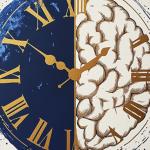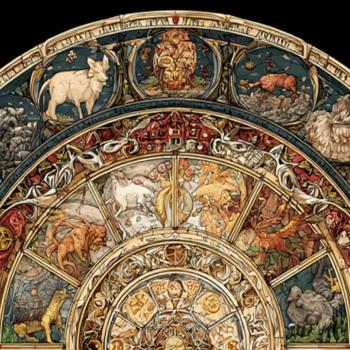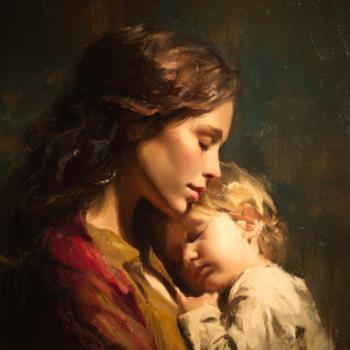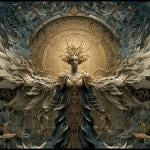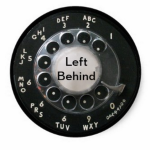
“Peter said to Mary, ‘Sister, we know that the Savior loved you more than the rest of the women. Tell us the words of the Savior which you remember, which you know and we do not, nor have we heard them.’ Mary answered and said, ‘What is hidden from you I will tell you.’ And she began to say to them these words. ‘I,’ she said, ‘I saw the Lord in a vision and I said to him, ‘Lord, I saw you today in a vision.’ He answered and said to me, ‘Blessed are you that you did not waver at seeing me. For where the mind is, there is the treasure.’ I said to him, ‘Lord, now, does one who sees the vision see it with the soul or with the spirit?’ The Savior answered and said, ‘One does not see with the soul or with the spirit, but the mind which is between the two sees the vision, [and] it…’” [The Gospel of Mary, Chapters 6-7]
[pages 11 – 14 are missing from the manuscript]
When Peter first asks Mary to share what she has heard from Jesus, he comes in humility and seems to have a genuine curiosity. His later response to what she tells the disciples betrays his true lack of interest in what she has to say to them. But, for now, he allows Mary to answer his question and begin speaking.
Sadly, the bulk of what she has to say has been lost to us. Either by an intentional act of censorship or from an accidental loss of integrity in the ancient text, we cannot know for certain. But, as noted scholar Elizabeth Schrader Polczer says, “The first few pages of the Gospel of Mary are missing but that’s not that uncommon. When you have a document from the fifth century, oftentimes those first pages are missing…what’s a little bit strange is that pages 11 through 14 have been removed.”[1]
Before we look into the mysterious contents of those missing pages, let’s first examine what takes place here just before their removal. Mary responds to Peter’s question and begins to share what she saw and heard from Jesus. The reference here to Mary “[seeing] the Lord in a vision” is a direct reference to what we read in the Gospel of John where it says that, at the resurrection, Mary saw Jesus at the tomb [see the Gospel of John, 20:14-17] and then ran to the disciples to report to them what she had seen, saying, “And she told them that he had said these things to her.” [v. 18]
If this reference is intentional [and some scholars believe that it is not an accidental reference], then what we can see is that those early [second century] believers who wrote the Gospel of Mary considered the resurrection encounter with Jesus to be a vision and not an appearance of Jesus in a physical body. Keep in mind that the Gospel of Mary is conservatively dated at around the second century as compared to the fourth century for the Gospel of John. So, the earlier view of those second-century followers of Christ was that the resurrection appearances of Jesus were a vision, which is significant. Even the Apostle Paul, when recounting his encounter with the resurrected Christ, admits that he saw something no one else saw and heard a voice that no one else could hear. This is consistent with a vision, and not with the appearance of a physical person.
So, after Mary tells the disciples that she has seen Jesus in a vision, she goes on to recount her conversation with Jesus [presumably at a later date] about the nature of that vision. First, Jesus commends her and blesses her “because [she] didn’t waiver at the sight of [him],” adding, “For where the mind is, there is the treasure.”
This saying from Mary’s Gospel corresponds slightly with another saying from Jesus in the canonical Gospels where he says:
“Do not lay up treasures for yourselves on earth, where moth and rust destroy and where thieves break in and steal, but lay up for yourselves treasures in heaven where neither moth nor rust destroys and where thieves do not break in and steal. For where your treasure is, there your heart will be also.” [Matthew 6:19-21, emphasis added]
However, in this Gospel, the saying is: “For where [your] mind is, there is [your] treasure.”
Can we reconcile these two sayings? Are they each separate sayings that apply in two different scenarios? Or was one saying transposed into the other? Honestly, we can’t say. Unless we had earlier copies of both Gospels to compare, we can’t really know the answers. However, we can assume the possibility that both sayings originate with Jesus simply because the words of Mary are not recorded for us in those other Gospel accounts. It is only in this Gospel of Mary that the Magdalene is given a voice, even if that voice is largely silenced by some unknown editor immediately after she begins to share her revelation with us.
In Matthew’s Gospel, the location of your treasure [in heaven or earth] reveals the location of your heart. But in Mary’s Gospel, it is the mind that becomes the treasure. Heaven and earth have nothing to do with it. So, the point here seems to be that the mind itself – whether in this life or the next – is to be valued and treasured above the rest. This has much to do with the earlier teachings about the Child of Humanity and the question of whether matter can be destroyed. Our bodies may wear out and die, but our minds – our true selves – cannot. We are eternal beings having a temporary physical experience.
This question of the mind comes up again immediately after this statement from Jesus when Mary asks:
“Lord, now, does one who sees the vision see it with the soul or with the spirit?” The Savior answered and said, “One does not see with the soul or with the spirit, but the mind which is between the two sees the vision…”
Mary has seen a vision of the resurrected Christ in her mind. This is not to diminish her vision or her experience in any way. On the contrary, according to Jesus, the mind is where our treasure is.
We might be tempted to detour her and explore the meaning and significance of the comparisons between the soul and the spirit and the mind, but that would be a distraction from what is really important in this text. Whether you see the soul and the spirit as interchangeable concepts, or if you see one as distinct from the other is of no importance. The mind is what matters here. The mind is where we see the vision of the resurrected Christ. The mind is the treasure.
“For as one thinks in his heart, so is he.” [Proverbs 23:7]
[1] As quoted from an interview with Elizabeth Schrader on the Heretic Happy Hour Podcast, Episode 193.
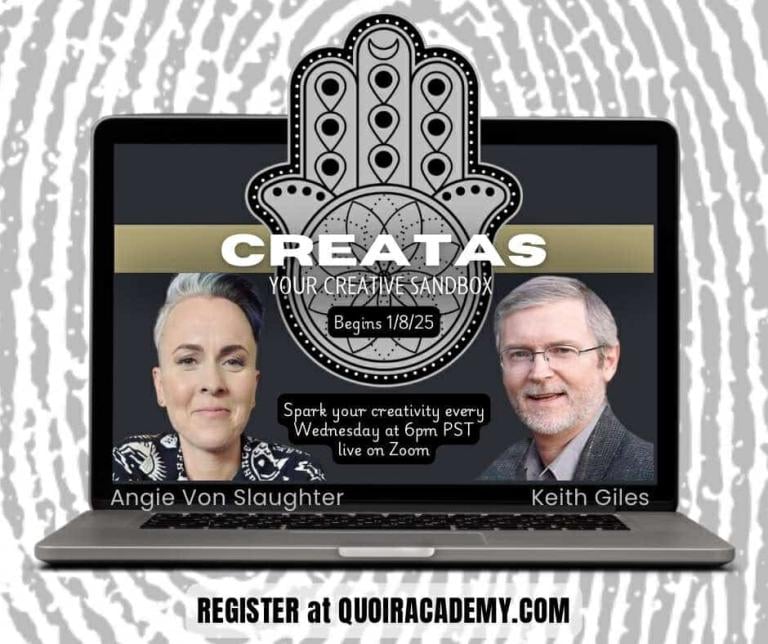
Excited to announce the new weekly online course I’ll be co-hosting with artist/musician Angie Von Slaughter starting Wednesday, January 8th.
Are you a creative person who struggles to find new ideas? Or maybe you’ve got too many ideas but you just don’t know how to get started? This course is a Live Online Zoom call where we gather with other artists to explore creativity and share exercises and prompts to help us unlock our creativity together.
Register now and save 20% off for a limited time only>
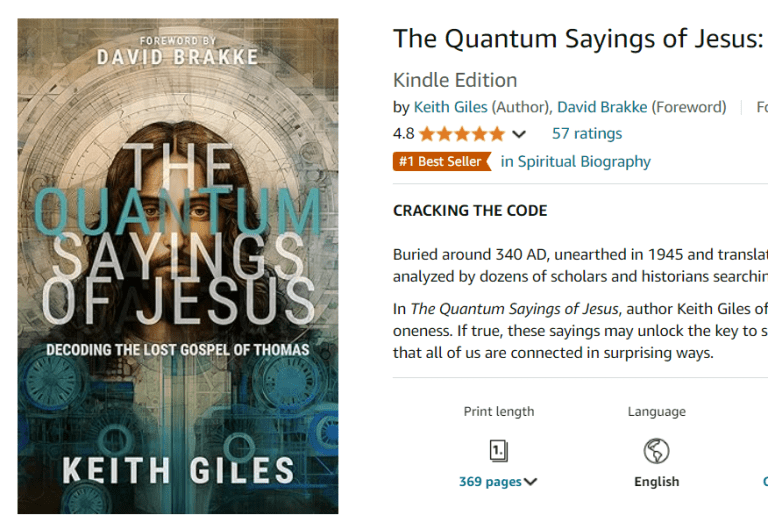
The newest book from Keith Giles, “The Quantum Sayings of Jesus: Decoding the Lost Gospel of Thomas” is available now on Amazon. Order HERE>
Keith Giles is the best-selling author of the Jesus Un series. He has appeared on CNN, USA Today, BuzzFeed, and John Fugelsang’s “Tell Me Everything.”
He co-hosts The Heretic Happy Hour Podcast and his solo podcast, Second Cup With Keith which are both available on Spotify, Amazon, Apple, Podbean or wherever you find your podcast fix.


